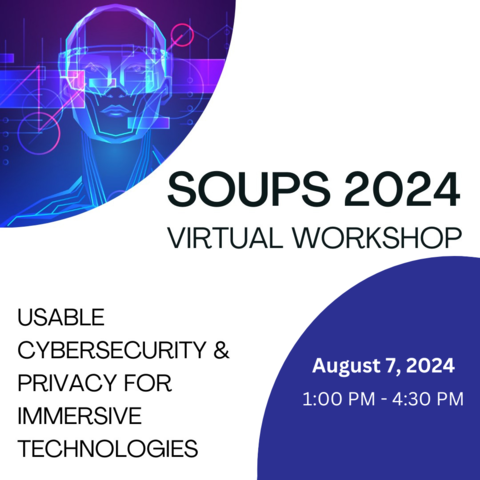SOUPS 2024 Virtual Workshop on Usable Cybersecurity and Privacy for Immersive Technologies

The Workshop is approaching! See registration information below.
Background:
Advances in computer vision, data processing, and other technologies has laid the foundation for novel virtual reality (VR), augmented reality (AR), and mixed reality (MR) solutions, collectively called immersive technologies. Immersive technologies are hardware and software systems that create interactive digital visual or spatial environments. These technologies hold promise to drive innovation and economic growth in numerous areas such as workforce, accessibility, and healthcare, but they challenge existing assumptions and practices for digital technologies. For example, large amounts of data may be collected from or about people to create digital worlds or augment the real world, and users can interact with immersive technologies in different ways than other technologies. Cybersecurity and privacy related to immersive technologies must be considered carefully. Immersive technologies may create cybersecurity and privacy risks, some perhaps novel and unique that will need to be managed, but they may also have potential for cybersecurity and privacy protections and other risk mitigations. All the while, users are at the center of these technologies, making usability considerations for immersive technologies critical for cybersecurity and privacy. For example, certain communication modalities may be more effective (i.e. due to use of audio and visual features); whereas, modalities that only include text or menus to navigate content are less effective for delivering cybersecurity and privacy information via immersive technologies. Not considering usability in this context risks users not using or misusing cybersecurity features, privacy features, or the technologies themselves. This virtual workshop is a pre-symposium event related to the Twentieth Symposium on Usable Privacy and Security, and it will explore immersive technologies and the cybersecurity and privacy considerations they introduce. We invite submissions on the following topics:
- Usable cybersecurity and privacy considerations for immersive technologies, with particular interest in novel considerations.
- Potential approaches for usable cybersecurity and privacy (e.g., risk mitigations) for immersive technology solutions and use cases.
- Potential usable cybersecurity and privacy mitigations that may utilize immersive technologies to deliver protections.
- How usable cybersecurity and privacy impact, or are impacted by, other trust factors (i.e., safety, resiliency, reliability) for immersive technology solutions and use cases.
- Insights for standards and standards development for immersive technologies and use cases.
Before the Workshop:
The submission period has closed. Please see the agenda below.
Register for the workshop at https://nist.zoomgov.com/meeting/register/vJIsd-uvqD4sHl8dsVR5zyP5QROCvlpusN0
Agenda
1:00pm-1:15pm – Introduction and Background
1:15pm-1:45pm – Opening Keynote - Our Next Reality: the Emerging Dangers of our AI-powered Immersive Future - Dr. Louis Rosenberg will review the rapid convergence of immersive technologies and artificial intelligence and discuss the risks it poses to personal privacy and human agency. He will also discuss the AI Manipulation Problem and the unique dangers that emerge when users interact conversationally with context-aware AI agents in both traditional and immersive environments.
- Presented by Louis Rosenberg, PhD - Unanimous AI and the Responsible Metaverse Alliance
1:45pm-2:45pm – Research Paper Presentation and Discussion Session
- Paper 1: “Trusted Inter-Reality Infrastructure: Building Trust within Entities (Digest)"
- Authors: Akira Kanaoka, Toho University and Takuro Yonezawa, Nagoya University
- Paper 2: “Understanding the Interdependence of Trust Factors and Usability in Cybersecurity and Privacy for Immersive Technologies”
- Authors: Bhanujeet Choudhary, David Tulacz, Kavya Pearlman, and Nandita Rao Narla, XRSI
2:45pm-3:00pm – Break
3:00pm-4:15pm – Panel Discussion Session – As immersive technologies such as virtual reality and augmented reality gain adoption we must consider how these solutions and their form factors, data processing scales, etc. may impact individuals. Join an expert panel as they discuss current and potential future considerations for usable privacy and security related to immersive technologies.
Moderator: Dylan Gilbert, Privacy Policy Advisor, NIST Privacy Engineering Program
Panelists:
Elizabeth Hyman, President and CEO, XR Association
Christopher Lafayette, Emergent Technologist, Gatherverse
Jameson Spivack, Senior Policy Analyst for Immersive Technologies, Future of Privacy Forum
4:15pm-4:30pm – Closing
After the Workshop:
NIST will publish a report of the workshop, summarizing the presentations, insights gathered, and potential next steps for usable cybersecurity and privacy for immersive technologies.
If you have any questions, please email the organizers at immersivetech [at] nist.gov (immersivetech[at]nist[dot]gov)
NIST Speakers
Presentation Materials
SOUPS Immersive Technology Workshop Call for Papers 2024 (114.67 KB)This event page exists for the limited purpose of identifying where and when NIST employees will be speaking or presenting with respect to the topics identified. The existence of this page is not intended to imply a recommendation or endorsement of this event or its organizers. After the presentation, NIST will endeavor to make the materials created and presented by NIST employees available on this page, at no cost.

